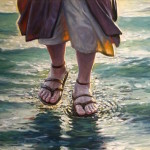How Richard Dawkins Helps Prove Biblical Inspiration
by Joe Heschmeyer
Filed under New Atheists, The Bible
American Atheists responded to the Pennsylvania state legislature’s designation of 2012 as “Year of the Bible” with mocking billboards, and a press release insisting that “the House of Representatives should not be celebrating a barbaric and Bronze Age book.” It’s a common argument against the Bible, that it can’t be trusted because it’s a book from the Bronze Age. Over on Twitter, Richard Dawkins extended this argument to attack both the Bible and the Qu’ran.
Bible and Quran were the best that Bronze Age desert tribes could do. But we’ve moved on. And even at the time, others were doing it better.
— Richard Dawkins (@RichardDawkins) May 17, 2015
Factually, the argument is wide of the mark. Despite its name, the Bible isn’t a book, but a collection of books, the majority of which were written several centuries after the Bronze Age. (The New Testament is closer in age to the foundation of the University of Paris in the High Middle Ages than it is to the close of the Bronze Age in c. 1200 B.C.). Historical inaccuracies aside, Dawkins' argument relies upon a sort of genetic fallacy, the assumption that certain beliefs can be proven false simply because they’re old. But this assumption doesn’t withstand scrutiny. We don’t reason, for example, that murder must be okay simply because people have always thought it was wrong.
Furthermore, this Bronze Age argument is circular. It assumes that the Bible is wrong because it was written by ignorant people. But this assumes, in turn, that the human authors of Scripture were limited to the knowledge otherwise attainable at that time and place, the very question in dispute in debating the authenticity of the Bible. In other words, the strength of this argument relies upon a prior assumption that the Bible is wrong – for example, in its claim to divine inspiration – and concluding from this that the Bible is wrong.
Curiously, in characterizing the Scriptural authors as ignorant and uneducated, American Atheists finds an unlikely ally: Saint Luke, the author of the Book of Acts. In Acts 4:13, he says that when the Jewish Temple authorities “saw the boldness of Peter and John, and perceived that they were uneducated, common men, they wondered; and they recognized that they had been with Jesus.” Luke doesn’t sugarcoat the truth. Peter and John, who together authored seven of the 27 books of the New Testament, were uneducated commoners. But rather than a cause for arrogant dismissal, this should lead us, as it did the Temple authorities, to a state of wonder. If the human authors of Scripture were “Bronze Aged” ignoramuses, how do we account for the credibility of the Apostles’ testimony?
Recall that the Bible isn’t, as American Atheists suggests, a single book. Instead, it’s a collection of centuries worth of religious texts, including centuries worth of Messianic prophecies. This means that, unlike the Qu’ran or the Book of Mormon, the prophecies and the accounts of the fulfillment of these prophecies aren’t coming from the same sources. This makes it all the more remarkable that the life of Jesus Christ so neatly fits the time and place foretold by the Jewish prophets.
For example, the Book of Daniel foretold that “the God of heaven will set up a kingdom which shall never be destroyed” during the fourth kingdom after the then-reigning Babylonians, a timeline corresponding with the Roman Empire. The Book of Micah specifies that the Messiah will come from Bethlehem, and be of the tribe of Judah. The Books of Malachi and Haggai prophesied that the Second Temple of Jerusalem (destroyed in 70 A.D.) would be greater than the First Temple because the Lord Himself would enter it. And Psalm 22 depicted the Messiah as being executed by having his hands and feet pierced, a description eerily reminiscent of Crucifixion, despite having been written several centuries prior to its invention.
Christ meets all of these criteria: no small feat, given that none of these factors involved events within the Apostles’ control. He rose to prominence from a very particular part of the world, within a very particular time frame. A generation after His death, the Second Temple, so central to the Malachi and Haggai prophecies, was permanently destroyed. Nevertheless, these prophecies might serve as a baseline, of sorts. Anyone claiming to be the Messiah would need, at the very least, to meet these criteria. But the Apostolic message is profound, in that it goes beyond claiming that Christ fulfilled these explicit prophecies.
Instead, they view Him as so much more, as the key to revealing the deepest meanings of Scripture as a whole: “beginning with Moses and all the prophets, he interpreted to them in all the scriptures the things concerning himself” (Luke 24:27). Countless passages which, on face, don’t even appear prophetic are revealed to have a Christological dimension. To take a single example, consider John 19:32-34, “So the soldiers came and broke the legs of the first, and of the other who had been crucified with him; but when they came to Jesus and saw that he was already dead, they did not break his legs. But one of the soldiers pierced his side with a spear, and at once there came out blood and water.”
In verse 36, John explains that this “fulfilled” the Scripture saying that not one of his bones would be broken. But that doesn’t come from an obvious Messianic prophecy; it comes from the instructions for preparing the Passover Lamb. And the water that streams out alongside the blood isn’t just a sign that Christ’s body has ceased metabolism. It’s a fulfillment of the Temple prophecies in Ezekiel. The last several chapters of the Book of Ezekiel describe a miraculous Temple from the side of which will flow life-giving waters. In John 2:21, John explains that this Temple is Jesus’ Body, and Christ applies the life-giving waters prophecy specifically in John 7:38.
This, in turn, points to the Sacramental theology latent in this passage: the life-giving waters flowing from the side of Christ signify Baptism, just as the blood signifies the Eucharist. These two Mysteries together form the Church, revealing yet another sets of Scriptures which are fulfilled: “As Eve was formed from the sleeping Adam’s side, so the Church was born from the pierced heart of Christ hanging dead on the cross” (CCC 766). In a single event, we see the meanings of several parts of Scripture, from the story of Adam and Eve to the Passover ordinances to the Temple prophecies, revealed in a radical new light as prophetic of the Messiah. Unlike the explicit Messianic prophecies, these weren’t predictions that the Apostles “had” to show as fulfilled in order to present Jesus as the Christ. And yet the Gospels are filled with events like this one, each one chock full of meaning and Scriptural significance.
Now perhaps this could be the work of a literary genius, who found a way to take the whole Jewish religious tradition, set it in the context of a single (real or fictional) human life, and combine the various prophecies and literary elements like so many instruments in an orchestra. But of course, the New Testament is no more the work of a single author than is the Old Testament, and we know from Roman sources like Pliny and Tatian that there were already Christians followers in the 50s and 60s A.D., before most of the New Testament (including the Gospels) was written. So the skeptic is left positing, not a single genius, but a cabal of geniuses, conspiring to craft a false Messianic narrative for reasons not immediately apparent. (This is precisely the direction skeptical Biblical scholarship has gone, creating ever-more complex theories about the textual origins of the Bible,)
But even if you’re willing to accept that sort of theory, it’s squarely contradicted by the charge of Bronze Age barbarism. You can’t simultaneously write off the Scriptural authors as halfwits and as too clever by half. The Bible can be primitive nonsense, or it could be an elaborate fraud, but it can’t very well be both. If Richard Dawkins, the American Atheists, and St. Luke are right that many of the writers of the New Testament were simple, uneducated folk, then it’s hard to explain away the literary genius of the New Testament as anything less than Divine inspiration.
Related Posts
Note: Our goal is to cultivate serious and respectful dialogue. While it's OK to disagree—even encouraged!—any snarky, offensive, or off-topic comments will be deleted. Before commenting please read the Commenting Rules and Tips. If you're having trouble commenting, read the Commenting Instructions.













